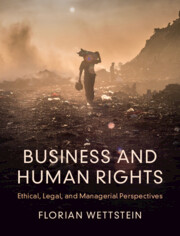Refine search
Actions for selected content:
36846 results in Cambridge Textbooks
15 - Concluding Remarks
- from Part III - External Relations
-
- Book:
- An Introduction to International Organizations Law
- Published online:
- 10 February 2022
- Print publication:
- 10 March 2022, pp 340-345
-
- Chapter
- Export citation
Index
-
- Book:
- Merrills' International Dispute Settlement
- Published online:
- 07 March 2022
- Print publication:
- 10 March 2022, pp 459-482
-
- Chapter
- Export citation
Preface
-
- Book:
- The Anthropology of Childhood
- Published online:
- 15 March 2022
- Print publication:
- 10 March 2022, pp xv-xxii
-
- Chapter
- Export citation
3 - The Legal Position of International Organizations
- from Part I - Member States and International Organization
-
- Book:
- An Introduction to International Organizations Law
- Published online:
- 10 February 2022
- Print publication:
- 10 March 2022, pp 41-70
-
- Chapter
- Export citation
1 - Where Do Children Come from?
-
- Book:
- The Anthropology of Childhood
- Published online:
- 15 March 2022
- Print publication:
- 10 March 2022, pp 1-26
-
- Chapter
- Export citation
7 - Privileges and Immunities
- from Part I - Member States and International Organization
-
- Book:
- An Introduction to International Organizations Law
- Published online:
- 10 February 2022
- Print publication:
- 10 March 2022, pp 132-156
-
- Chapter
- Export citation
6 - Of Marbles and Morals
-
- Book:
- The Anthropology of Childhood
- Published online:
- 15 March 2022
- Print publication:
- 10 March 2022, pp 215-254
-
- Chapter
- Export citation
2 - Instructions Sets, Software, and Instruction Execution
-
- Book:
- Computer Architecture for Scientists
- Published online:
- 25 March 2022
- Print publication:
- 10 March 2022, pp 16-47
-
- Chapter
- Export citation
10 - The Law of the Sea Convention
-
- Book:
- Merrills' International Dispute Settlement
- Published online:
- 07 March 2022
- Print publication:
- 10 March 2022, pp 261-309
-
- Chapter
- Export citation
Preface
-
- Book:
- Computer Architecture for Scientists
- Published online:
- 25 March 2022
- Print publication:
- 10 March 2022, pp xi-xii
-
- Chapter
- Export citation
Preface to the Fourth Edition
-
- Book:
- An Introduction to International Organizations Law
- Published online:
- 10 February 2022
- Print publication:
- 10 March 2022, pp xi-xii
-
- Chapter
- Export citation
Copyright page
-
- Book:
- The Anthropology of Childhood
- Published online:
- 15 March 2022
- Print publication:
- 10 March 2022, pp iv-iv
-
- Chapter
- Export citation
9 - Taming the Autonomous Learner
-
- Book:
- The Anthropology of Childhood
- Published online:
- 15 March 2022
- Print publication:
- 10 March 2022, pp 339-380
-
- Chapter
- Export citation

Merrills' International Dispute Settlement
-
- Published online:
- 07 March 2022
- Print publication:
- 10 March 2022
-
- Textbook
- Export citation

Business and Human Rights
- Ethical, Legal, and Managerial Perspectives
-
- Published online:
- 05 March 2022
- Print publication:
- 24 March 2022
-
- Textbook
- Export citation
Frontmatter
-
- Book:
- An Introduction to Public International Law
- Published online:
- 17 February 2022
- Print publication:
- 03 March 2022, pp i-iv
-
- Chapter
- Export citation
8 - International Organizations
- from Part I - The Foundations of Public International Law
-
-
- Book:
- An Introduction to Public International Law
- Published online:
- 17 February 2022
- Print publication:
- 03 March 2022, pp 141-161
-
- Chapter
- Export citation
14 - International Economic Law
- from Part II - The Branches of Public International Law
-
-
- Book:
- An Introduction to Public International Law
- Published online:
- 17 February 2022
- Print publication:
- 03 March 2022, pp 276-298
-
- Chapter
- Export citation
9 - International Dispute Settlement
- from Part I - The Foundations of Public International Law
-
-
- Book:
- An Introduction to Public International Law
- Published online:
- 17 February 2022
- Print publication:
- 03 March 2022, pp 162-184
-
- Chapter
- Export citation
Contents
-
- Book:
- An Introduction to Public International Law
- Published online:
- 17 February 2022
- Print publication:
- 03 March 2022, pp v-vi
-
- Chapter
- Export citation
